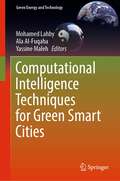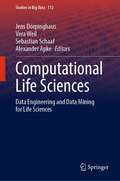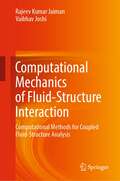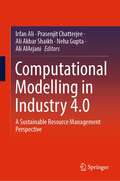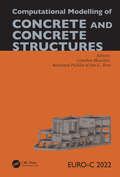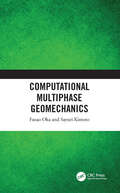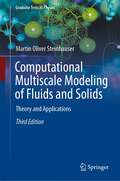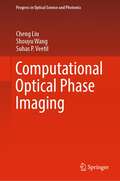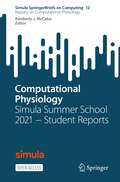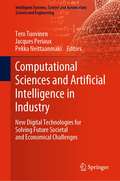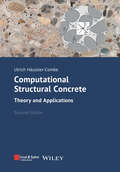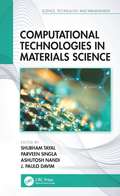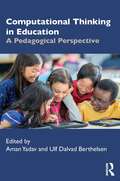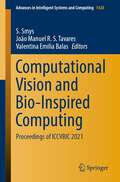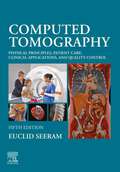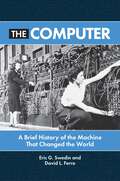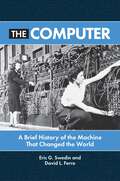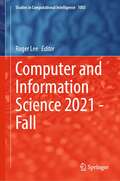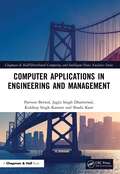- Table View
- List View
Computational Intelligence Techniques for Green Smart Cities (Green Energy and Technology)
by Mohamed Lahby Ala Al-Fuqaha Yassine MalehThis book contains high-quality and original research on computational intelligence for green smart cities research. In recent years, the use of smart city technology has rapidly increased through the successful development and deployment of Internet of Things (IoT) architectures. The citizens' quality of life has been improved in several sensitive areas of the city, such as transportation, buildings, health care, education, environment, and security, thanks to these technological advancesComputational intelligence techniques and algorithms enable a computational analysis of enormous data sets to reveal patterns that recur. This information is used to inform and improve decision-making at the municipal level to build smart computational intelligence techniques and sustainable cities for their citizens. Machine intelligence allows us to identify trends (patterns). The smart city could better integrate its transportation network, for example. By offering a better public transportation network adapted to the demand, we could reduce personal vehicles and energy consumption. A smart city could use models to predict the consequences of a change, such as pedestrianizing a street or adding a bike lane. A city can even create a 3D digital twin to test hypothetical projects. This book comprises many state-of-the-art contributions from scientists and practitioners working in machine intelligence and green smart cities. It aspires to provide a relevant reference for students, researchers, engineers, and professionals working in this area or those interested in grasping its diverse facets and exploring the latest advances in machine intelligence for green and sustainable smart city applications.
Computational Life Sciences: Data Engineering and Data Mining for Life Sciences (Studies in Big Data #112)
by Jens Dörpinghaus Vera Weil Sebastian Schaaf Alexander ApkeThis book broadly covers the given spectrum of disciplines in Computational Life Sciences, transforming it into a strong helping hand for teachers, students, practitioners and researchers. In Life Sciences, problem-solving and data analysis often depend on biological expertise combined with technical skills in order to generate, manage and efficiently analyse big data. These technical skills can easily be enhanced by good theoretical foundations, developed from well-chosen practical examples and inspiring new strategies. This is the innovative approach of Computational Life Sciences-Data Engineering and Data Mining for Life Sciences: We present basic concepts, advanced topics and emerging technologies, introduce algorithm design and programming principles, address data mining and knowledge discovery as well as applications arising from real projects. Chapters are largely independent and often flanked by illustrative examples and practical advise.
Computational Mechanics of Fluid-Structure Interaction: Computational Methods for Coupled Fluid-Structure Analysis
by Rajeev Kumar Jaiman Vaibhav JoshiThis book is intended to provide a compilation of the state-of-the-art numerical methods for nonlinear fluid-structure interaction using the moving boundary Lagrangian-Eulerian formulation. Single and two-phase viscous incompressible fluid flows are considered with the increasing complexity of structures ranging from rigid-body, linear elastic and nonlinear large deformation to fully-coupled flexible multibody system. This book is unique with regard to computational modeling of such complex fluid-structure interaction problems at high Reynolds numbers, whereby various coupling techniques are introduced and systematically discussed. The techniques are demonstrated for large-scale practical problems in aerospace and marine/offshore engineering. This book also provides a comprehensive understanding of underlying unsteady physics and coupled mechanical aspects of the fluid-structure interaction from a computational point of view. Using the body-fitted and moving mesh formulations, the physical insights associated with structure-to-fluid mass ratios (i.e., added mass effects), Reynolds number, large structural deformation, free surface, and other interacting physical fields are covered. The book includes the basic tools necessary to build the concepts required for modeling such coupled fluid-structure interaction problems, thus exposing the reader to advanced topics of multiphysics and multiscale phenomena.
Computational Modelling in Industry 4.0: A Sustainable Resource Management Perspective
by Ali Akbar Shaikh Irfan Ali Neha Gupta Prasenjit Chatterjee Ali AlArjaniThis book addresses the different problems, practices, challenges and opportunities in sustainable resource management with the help of decision-making techniques to showcase the relevance of computational modelling approaches in sustainable management and Industry 4.0. It aims to address the inherent complexity of managing ecosystems, particularly with respect to involvement of multi-stakeholders, lack of information and uncertainties. Critical analyses are made to point out the need for, and propose a call to, a new way of thinking about sustainable resource management. This book will be useful for academicians, researchers, and industrialists in the field of industrial and production engineering.
Computational Modelling of Concrete and Concrete Structures
by Günther MeschkeComputational Modelling of Concrete and Concrete Structures contains the contributions to the EURO-C 2022 conference (Vienna, Austria, 23-26 May 2022). The papers review and discuss research advancements and assess the applicability and robustness of methods and models for the analysis and design of concrete, fibre-reinforced and prestressed concrete structures, as well as masonry structures. Recent developments include methods of machine learning, novel discretisation methods, probabilistic models, and consideration of a growing number of micro-structural aspects in multi-scale and multi-physics settings. In addition, trends towards the material scale with new fibres and 3D printable concretes, and life-cycle oriented models for ageing and durability of existing and new concrete infrastructure are clearly visible. Overall computational robustness of numerical predictions and mathematical rigour have further increased, accompanied by careful model validation based on respective experimental programmes. The book will serve as an important reference for both academics and professionals, stimulating new research directions in the field of computational modelling of concrete and its application to the analysis of concrete structures. EURO-C 2022 is the eighth edition of the EURO-C conference series after Innsbruck 1994, Bad Gastein 1998, St. Johann im Pongau 2003, Mayrhofen 2006, Schladming 2010, St. Anton am Arlberg 2014, and Bad Hofgastein 2018. The overarching focus of the conferences is on computational methods and numerical models for the analysis of concrete and concrete structures.
Computational Modelling of Concrete and Concrete Structures
by Günther Meschke Bernhard Pichler Jan G. RotsComputational Modelling of Concrete and Concrete Structures contains the contributions to the EURO-C 2022 conference (Vienna, Austria, 23-26 May 2022). The papers review and discuss research advancements and assess the applicability and robustness of methods and models for the analysis and design of concrete, fibre-reinforced and prestressed concrete structures, as well as masonry structures. Recent developments include methods of machine learning, novel discretisation methods, probabilistic models, and consideration of a growing number of micro-structural aspects in multi-scale and multi-physics settings. In addition, trends towards the material scale with new fibres and 3D printable concretes, and life-cycle oriented models for ageing and durability of existing and new concrete infrastructure are clearly visible. Overall computational robustness of numerical predictions and mathematical rigour have further increased, accompanied by careful model validation based on respective experimental programmes. The book will serve as an important reference for both academics and professionals, stimulating new research directions in the field of computational modelling of concrete and its application to the analysis of concrete structures. EURO-C 2022 is the eighth edition of the EURO-C conference series after Innsbruck 1994, Bad Gastein 1998, St. Johann im Pongau 2003, Mayrhofen 2006, Schladming 2010, St. Anton am Arlberg 2014, and Bad Hofgastein 2018. The overarching focus of the conferences is on computational methods and numerical models for the analysis of concrete and concrete structures.
Computational Multiphase Geomechanics
by Fusao Oka Sayuri KimotoNumerical methods are very powerful tools for use in geotechnical engineering, particularly in computational geotechnics. Interest is strong in the new field of multi-phase nature of geomaterials, and the area of computational geotechnics is expanding. Alongside their companion volume Computational Modeling of Multiphase Geomaterials (CRC Press, 2012), Fusao Oka and Sayuri Kimoto cover recent progress in several key areas, such as air-water-soil mixture, cyclic constitutive models, anisotropic models, noncoaxial models, gradient models, compaction bands (a form of volumetric strain localization and strain localization under dynamic conditions), and the instability of unsaturated soils. The text also includes applications of computational modeling to large-scale excavation of ground, liquefaction analysis of levees during earthquakes, methane hydrate development, and the characteristics of contamination using bentonite. The erosion of embankments due to seepage flow is also presented.
Computational Multiphase Geomechanics
by Fusao Oka Sayuri KimotoNumerical methods are very powerful tools for use in geotechnical engineering, particularly in computational geotechnics. Interest is strong in the new field of multi-phase nature of geomaterials, and the area of computational geotechnics is expanding. Alongside their companion volume Computational Modeling of Multiphase Geomaterials (CRC Press, 2012), Fusao Oka and Sayuri Kimoto cover recent progress in several key areas, such as air-water-soil mixture, cyclic constitutive models, anisotropic models, noncoaxial models, gradient models, compaction bands (a form of volumetric strain localization and strain localization under dynamic conditions), and the instability of unsaturated soils. The text also includes applications of computational modeling to large-scale excavation of ground, liquefaction analysis of levees during earthquakes, methane hydrate development, and the characteristics of contamination using bentonite. The erosion of embankments due to seepage flow is also presented.
Computational Multiscale Modeling of Fluids and Solids: Theory and Applications (Graduate Texts in Physics)
by Martin Oliver SteinhauserThe expanded 3rd edition of this established textbook offers an updated overview and review of the computational physics techniques used in materials modelling over different length and time scales. It describes in detail the theory and application of some of the most important methods used to simulate materials across the various levels of spatial and temporal resolution. Quantum mechanical methods such as the Hartree-Fock approximation for solving the Schrödinger equation at the smallest spatial resolution are discussed as well as the Molecular Dynamics and Monte-Carlo methods on the micro- and meso-scale up to macroscopic methods used predominantly in the Engineering world such as Finite Elements (FE) or Smoothed Particle Hydrodynamics (SPH). Extensively updated throughout, this new edition includes additional sections on polymer theory, statistical physics and continuum theory, the latter being the basis of FE methods and SPH. Each chapter now first provides an overview of the key topics covered, with a new “key points” section at the end. The book is aimed at beginning or advanced graduate students who want to enter the field of computational science on multi-scales. It provides an in-depth overview of the basic physical, mathematical and numerical principles for modelling solids and fluids on the micro-, meso-, and macro-scale. With a set of exercises, selected solutions and several case studies, it is a suitable book for students in physics, engineering, and materials science, and a practical reference resource for those already using materials modelling and computational methods in their research.
Computational Optical Phase Imaging (Progress in Optical Science and Photonics #21)
by Cheng Liu Shouyu Wang Suhas P. VeetilIn this book, computational optical phase imaging techniques are presented along with Matlab codes that allow the reader to run their own simulations and gain a thorough understanding of the current state-of-the-art. The book focuses on modern applications of computational optical phase imaging in engineering measurements and biomedical imaging. Additionally, it discusses the future of computational optical phase imaging, especially in terms of system miniaturization and deep learning-based phase retrieval.
Computational Physiology: Simula Summer School 2021 − Student Reports (Simula SpringerBriefs on Computing #12)
This open access volume compiles student reports from the 2021 Simula Summer School in Computational Physiology. Interested readers will find herein a number of modern approaches to modeling excitable tissue. This should provide a framework for tools available to model subcellular and tissue-level physiology across scales and scientific questions. In June through August of 2021, Simula held the seventh annual Summer School in Computational Physiology in collaboration with the University of Oslo (UiO) and the University of California, San Diego (UCSD). The course focuses on modeling excitable tissues, with a special interest in cardiac physiology and neuroscience. The majority of the school consists of group research projects conducted by Masters and PhD students from around the world, and advised by scientists at Simula, UiO and UCSD. Each group then produced a report that addreses a specific problem of importance in physiology and presents a succinct summary of the findings. Reports may not necessarily represent new scientific results; rather, they can reproduce or supplement earlier computational studies or experimental findings. Reports from eight of the summer projects are included as separate chapters. The fields represented include cardiac geometry definition (Chapter 1), electrophysiology and pharmacology (Chapters 2–5), fluid mechanics in blood vessels (Chapter 6), cardiac calcium handling and mechanics (Chapter 7), and machine learning in cardiac electrophysiology (Chapter 8).
Computational Sciences and Artificial Intelligence in Industry: New Digital Technologies for Solving Future Societal and Economical Challenges (Intelligent Systems, Control and Automation: Science and Engineering #76)
by Tero Tuovinen Jacques Periaux Pekka NeittaanmäkiThis book is addressed to young researchers and engineers in the fields of Computational Science and Artificial Intelligence, ranging from innovative computational methods to digital machine learning tools and their coupling used for solving challenging industrial and societal problems.This book provides the latest knowledge from jointly academic and industries experts in Computational Science and Artificial Intelligence fields for exploring possibilities and identifying challenges of applying Computational Sciences and AI methods and tools in industrial and societal sectors.
Computational Structural Concrete: Theory and Applications
by Ulrich Haussler-CombeConcrete is by far the most used building material due to its advantages: it is shapeable, cost-effective and available everywhere. Combined with reinforcement it provides an immense bandwidth of properties and may be customized for a huge range of purposes. Thus, concrete is the building material of the 20th century. To be the building material of the 21th century its sustainability has to move into focus. Reinforced concrete structures have to be designed expending less material whereby their load carrying potential has to be fully utilized. Computational methods such as Finite Element Method (FEM) provide essential tools to reach the goal. In combination with experimental validation, they enable a deeper understanding of load carrying mechanisms. A more realistic estimation of ultimate and serviceability limit states can be reached compared to traditional approaches. This allows for a significantly improved utilization of construction materials and a broader horizon for innovative structural designs opens up. However, sophisticated computational methods are usually provided as black boxes. Data is fed in, the output is accepted as it is, but an understanding of the steps in between is often rudimentary. This has the risk of misinterpretations, not to say invalid results compared to initial problem definitions. The risk is in particular high for nonlinear problems. As a composite material, reinforced concrete exhibits nonlinear behaviour in its limit states, caused by interaction of concrete and reinforcement via bond and the nonlinear properties of the components. Its cracking is a regular behaviour. The book aims to make the mechanisms of reinforced concrete transparent from the perspective of numerical methods. In this way, black boxes should also become transparent. Appropriate methods are described for beams, plates, slabs and shells regarding quasi-statics and dynamics. Concrete creeping, temperature effects, prestressing, large displacements are treated as examples. State of the art concrete material models are presented. Both the opportunities and the pitfalls of numerical methods are shown. Theory is illustrated by a variety of examples. Most of them are performed with the ConFem software package implemented in Python and available under open-source conditions.
Computational Structural Concrete: Theory and Applications
by Ulrich Haussler-CombeConcrete is by far the most used building material due to its advantages: it is shapeable, cost-effective and available everywhere. Combined with reinforcement it provides an immense bandwidth of properties and may be customized for a huge range of purposes. Thus, concrete is the building material of the 20th century. To be the building material of the 21th century its sustainability has to move into focus. Reinforced concrete structures have to be designed expending less material whereby their load carrying potential has to be fully utilized. Computational methods such as Finite Element Method (FEM) provide essential tools to reach the goal. In combination with experimental validation, they enable a deeper understanding of load carrying mechanisms. A more realistic estimation of ultimate and serviceability limit states can be reached compared to traditional approaches. This allows for a significantly improved utilization of construction materials and a broader horizon for innovative structural designs opens up. However, sophisticated computational methods are usually provided as black boxes. Data is fed in, the output is accepted as it is, but an understanding of the steps in between is often rudimentary. This has the risk of misinterpretations, not to say invalid results compared to initial problem definitions. The risk is in particular high for nonlinear problems. As a composite material, reinforced concrete exhibits nonlinear behaviour in its limit states, caused by interaction of concrete and reinforcement via bond and the nonlinear properties of the components. Its cracking is a regular behaviour. The book aims to make the mechanisms of reinforced concrete transparent from the perspective of numerical methods. In this way, black boxes should also become transparent. Appropriate methods are described for beams, plates, slabs and shells regarding quasi-statics and dynamics. Concrete creeping, temperature effects, prestressing, large displacements are treated as examples. State of the art concrete material models are presented. Both the opportunities and the pitfalls of numerical methods are shown. Theory is illustrated by a variety of examples. Most of them are performed with the ConFem software package implemented in Python and available under open-source conditions.
Computational Technologies in Materials Science (Science, Technology, and Management)
by Shubham Tayal Parveen Singla Ashutosh Nandi J. Paulo DavimAdvanced materials are essential for economic security and human well-being, with applications in industries aimed at addressing challenges in clean energy, national security, and human welfare. Yet, it can take years to move a material to the market after its initial discovery. Computational techniques have accelerated the exploration and development of materials, offering the chance to move new materials to the market quickly. Computational Technologies in Materials Science addresses topics related to AI, machine learning, deep learning, and cloud computing in materials science. It explores characterization and fabrication of materials, machine-learning-based models, and computational intelligence for the synthesis and identification of materials. This book • Covers material testing and development using computational intelligence • Highlights the technologies to integrate computational intelligence and materials science • Details case studies and detailed applications • Investigates challenges in developing and using computational intelligence in materials science • Analyzes historic changes that are taking place in designing materials. This book encourages material researchers and academics to develop novel theories and sustainable computational techniques and explores the potential for computational intelligence to replace traditional materials research.
Computational Technologies in Materials Science (Science, Technology, and Management)
by Shubham Tayal Parveen Singla Ashutosh Nandi J. Paulo DavimAdvanced materials are essential for economic security and human well-being, with applications in industries aimed at addressing challenges in clean energy, national security, and human welfare. Yet, it can take years to move a material to the market after its initial discovery. Computational techniques have accelerated the exploration and development of materials, offering the chance to move new materials to the market quickly. Computational Technologies in Materials Science addresses topics related to AI, machine learning, deep learning, and cloud computing in materials science. It explores characterization and fabrication of materials, machine-learning-based models, and computational intelligence for the synthesis and identification of materials. This book • Covers material testing and development using computational intelligence • Highlights the technologies to integrate computational intelligence and materials science • Details case studies and detailed applications • Investigates challenges in developing and using computational intelligence in materials science • Analyzes historic changes that are taking place in designing materials. This book encourages material researchers and academics to develop novel theories and sustainable computational techniques and explores the potential for computational intelligence to replace traditional materials research.
Computational Thinking in Education: A Pedagogical Perspective
by Aman YadavComputational Thinking in Education explores the relevance of computational thinking in primary and secondary education. As today’s school-aged students prepare to live and work in a thoroughly digitized world, computer science is providing a wealth of new learning concepts and opportunities across domains. This book offers a comprehensive overview of computational thinking, its history, implications for equity and inclusion, analyses of competencies in practice, and integration into learning, instruction, and assessment through scaffolded teacher education. Computer science education faculty and pre- and in-service educators will find a fresh pedagogical approach to computational thinking in primary and secondary classrooms.
Computational Thinking in Education: A Pedagogical Perspective
by Aman Yadav Ulf Dalvad BerthelsenComputational Thinking in Education explores the relevance of computational thinking in primary and secondary education. As today’s school-aged students prepare to live and work in a thoroughly digitized world, computer science is providing a wealth of new learning concepts and opportunities across domains. This book offers a comprehensive overview of computational thinking, its history, implications for equity and inclusion, analyses of competencies in practice, and integration into learning, instruction, and assessment through scaffolded teacher education. Computer science education faculty and pre- and in-service educators will find a fresh pedagogical approach to computational thinking in primary and secondary classrooms.
Computational Vision and Bio-Inspired Computing: Proceedings of ICCVBIC 2021 (Advances in Intelligent Systems and Computing #1420)
by S. Smys João Manuel R. S. Tavares Valentina Emilia BalasThis book includes selected papers from the 5th International Conference on Computational Vision and Bio Inspired Computing (ICCVBIC 2021), held in Coimbatore, India, during November 25–26, 2021. This book presents state-of-the-art research innovations in computational vision and bio-inspired techniques. The book reveals the theoretical and practical aspects of bio-inspired computing techniques, like machine learning, sensor-based models, evolutionary optimization and big data modeling and management that make use of effectual computing processes in the bio-inspired systems. It also contributes to the novel research that focuses on developing bio-inspired computing solutions for various domains, such as human–computer interaction, image processing, sensor-based single processing, recommender systems and facial recognition, which play an indispensable part in smart agriculture, smart city, biomedical and business intelligence applications.
Computed Tomography - E-Book: Physical Principles, Patient Care, Clinical Applications, and Quality Control
by Euclid SeeramBuild the foundation necessary for the practice of CT scanning with Computed Tomography: Physical Principles, Patient Care, Clinical Applications, and Quality Control, 5th Edition. Written to meet the varied requirements of radiography students and practitioners, this two-color text provides comprehensive coverage of the physical principles of computed tomography and its clinical applications. The clear, straightforward approach is designed to improve your understanding of sectional anatomic images as they relate to computed tomography and facilitate communication between CT technologists and other medical personnel. Chapter outlines and chapter review questions help you focus your study time and master content. NEW! Three additional chapters reflect the latest industry CT standards in imaging: Radiation Awareness and Safety Campaigns in Computed Tomography, Patient Care Considerations, and Artificial Intelligence: An Overview of Applications in Health and Medical Imaging. UPDATED! More than 509 photos and line drawings visually clarify key concepts. UPDATED! The latest information keeps you up to date on advances in volume CT scanning; CT fluoroscopy; and multislice applications like 3-D imaging, CT angiography, and virtual reality imaging (endoscopy).
The Computer: A Brief History of the Machine That Changed the World
by Eric G. Swedin David L. FerroThis book, aimed at general readers, covers the entirety of computing history from antiquity to the present, placing the story of computing into the broader context of politics, economics, society, and more.Computers dominate the world we live in, and this book describes how we got here. The Computer: A Brief History of the Machine That Changed the World covers topics from early efforts at mathematical computation back in ancient times, such as the abacus and the Antikythera device, through Babbage's Difference Engine and the Hollerith Tabulating Machines of the 19th century, to the eventual invention of the modern computer during World War II and its aftermath. The scope of the text reaches into the modern day, with chapters on social media and the influence of computers and technology on recent elections.The information in this book, perfect for readers new to the topic or those looking to delve into the history of computers in greater detail, can be accessed both chronologically and topically. With chapters focusing on larger time periods as well as shorter subsections covering specific people and topics, this book is designed to make the history of computing as approachable as possible.
The Computer: A Brief History of the Machine That Changed the World
by Eric G. Swedin David L. FerroThis book, aimed at general readers, covers the entirety of computing history from antiquity to the present, placing the story of computing into the broader context of politics, economics, society, and more.Computers dominate the world we live in, and this book describes how we got here. The Computer: A Brief History of the Machine That Changed the World covers topics from early efforts at mathematical computation back in ancient times, such as the abacus and the Antikythera device, through Babbage's Difference Engine and the Hollerith Tabulating Machines of the 19th century, to the eventual invention of the modern computer during World War II and its aftermath. The scope of the text reaches into the modern day, with chapters on social media and the influence of computers and technology on recent elections.The information in this book, perfect for readers new to the topic or those looking to delve into the history of computers in greater detail, can be accessed both chronologically and topically. With chapters focusing on larger time periods as well as shorter subsections covering specific people and topics, this book is designed to make the history of computing as approachable as possible.
Computer and Information Science 2021 - Fall (Studies in Computational Intelligence #1003)
by Roger LeeThis edited book presents scientific results of the 21th IEEE/ACIS International Fall Virtual Conference on Computer and Information Science (ICIS 2021-Fall) held on October 13-15, 2021, in Xi’an China. The aim of this conference was to bring together researchers and scientists, businessmen and entrepreneurs, teachers, engineers, computer users, and students to discuss the numerous fields of computer science and to share their experiences and exchange new ideas and information in a meaningful way. Research results about all aspects (theory, applications, and tools) of computer and information science and to discuss the practical challenges encountered along the way and the solutions adopted to solve them.The conference organizers selected the best papers from those papers accepted for presentation at the conference. The papers were chosen based on review scores submitted by members of the program committee and underwent further rigorous rounds of review. From this second round of review, 13 of the conference’s most promising papers are then published in this Springer (SCI) book and not the conference proceedings. We impatiently await the important contributions that we know these authors will bring to the field of computer and information science.
Computer Applications in Engineering and Management (Chapman & Hall/Distributed Computing and Intelligent Data Analytics Series)
by Parveen BerwalThe book Computer Applications in Engineering and Management is about computer applications in management, electrical engineering, electronics engineering, and civil engineering. It covers the software tools for office automation, introduces the basic concepts of database management, and provides an overview about the concepts of data communication, internet, and e-commerce. Additionally, the book explains the principles of computing management used in construction of buildings in civil engineering and the role of computers in power grid automation in electronics engineering. Features Provides an insight to prospective research and application areas related to industry and technology Includes industry-based inputs Provides a hands-on approach for readers of the book to practice and assimilate learning This book is primarily aimed at undergraduates and graduates in computer science, information technology, civil engineering, electronics and electrical engineering, management, academicians, and research scholars.
Computer Applications in Engineering and Management (Chapman & Hall/Distributed Computing and Intelligent Data Analytics Series)
by Parveen Berwal Jagjit Singh Dhatterwal Kuldeep Singh Kaswan Shashi KantThe book Computer Applications in Engineering and Management is about computer applications in management, electrical engineering, electronics engineering, and civil engineering. It covers the software tools for office automation, introduces the basic concepts of database management, and provides an overview about the concepts of data communication, internet, and e-commerce. Additionally, the book explains the principles of computing management used in construction of buildings in civil engineering and the role of computers in power grid automation in electronics engineering. Features Provides an insight to prospective research and application areas related to industry and technology Includes industry-based inputs Provides a hands-on approach for readers of the book to practice and assimilate learning This book is primarily aimed at undergraduates and graduates in computer science, information technology, civil engineering, electronics and electrical engineering, management, academicians, and research scholars.
